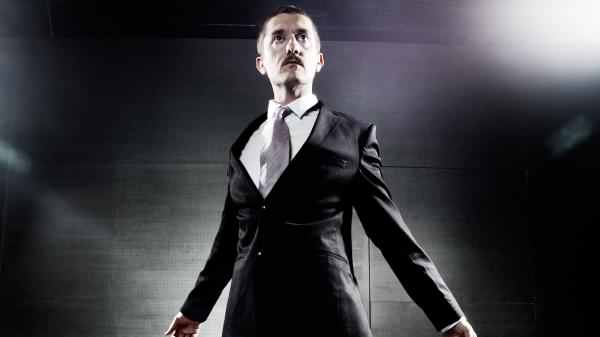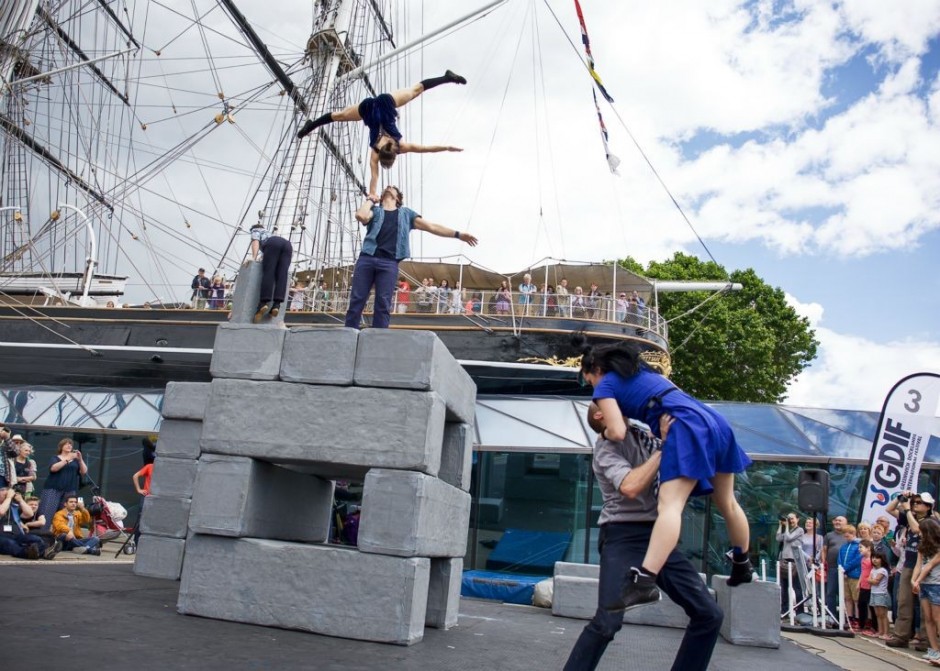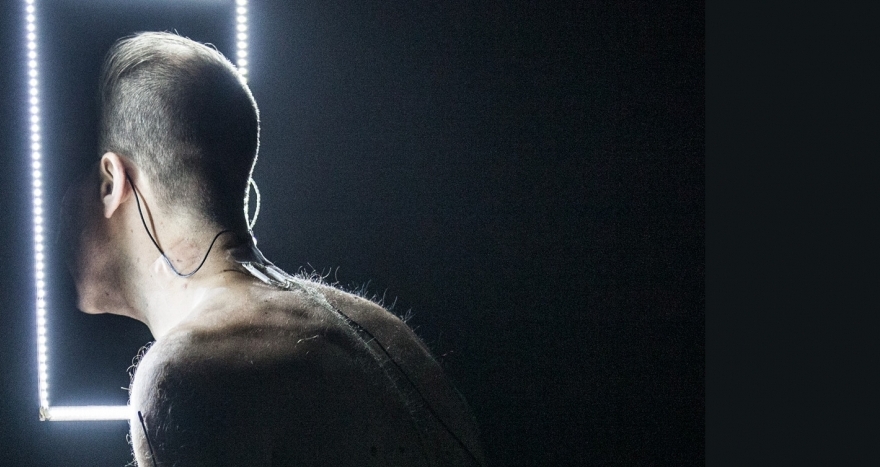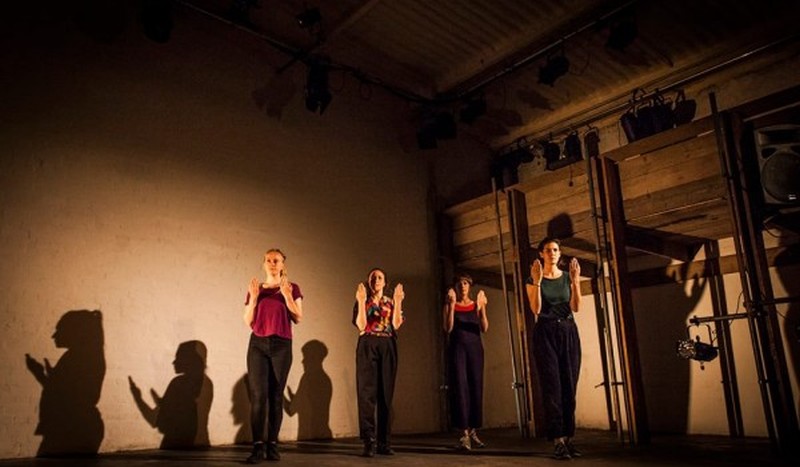Building blocks and planks, towers of people and pianos, guardian angels, and a street show featuring a bag lady – Rebecca Nice enjoys a weekend of sunshine and showers at the Greenwich and Docklands International Festival
2016 marks the 21st birthday of Greenwich+Docklands International Festival, which kicks off on Friday 24 June with The House, a late-night spectacle using music and projection to bring the National Maritime Museum alive with light and sound. The House is conceived and directed by the festival’s artistic director, Bradley Hemmings who has been awarded an MBE for his direction of the 2012 Paralympic Games opening ceremony and his ongoing work at the helm of GDIF.
Greenwich Fair runs for the first weekend in the grounds of the Old Royal Naval College and the Cutty Sark Ship, followed by a week of work across East London, culminating in Dancing City at Canary Wharf on the final weekend, with a finale show at the Royal Artillery Barracks, Woolwich on Saturday 2 July, The Clash of Drums, as part of the Arts Council’s Global Streets programme.
GDIF showcases spectacular circus, theatre and dance from all over the world and from communities closer to home, over its ten day span. Deaf and disabled artists are championed, from DJ Chinaman’s Deaf Rave to Candoco Dance Company’s collaboration with Arlene Philips in You and I Know, performed with disabled artists Joel Brown and Laura Patay.
Many of the British artists featured in the festival are supported by Without Walls, a consortium of eight festivals of which GDIF is a member. Without Walls commissions include Block, a new collaboration between Motionhouse and NoFit State Circus; New Art Club’s first outdoor work, Campervan of Love; and Miss High Leg Kick’s Audition Project, a participatory event in which people are invited to learn the dance steps from the audition scene from the 1985 film A Chorus Line. Each performance is filmed by Richard DeDomenici, who will eventually include it into his ongoing Redux project. GDIF 2016 also sees the premiere of the new Whalley Range All Stars’ show Ye Gods, which features a model village animated by three performers; and Home, a GDIF commission that brings together slapstick comedy with aerial circus and acrobatics in an interactive performance for all ages exploring ideas of home and homelessness.
International artists at this year’s festival include Teatr KTO with masked theatre production Peregrinus, the legendary Teatr Biuro Podrozy (also from Poland) with the dark and disturbing Silence, and Ulik Production’s Robotik Drumshow (from Germany), performed entirely on the arm of a robot used in the car making industry.
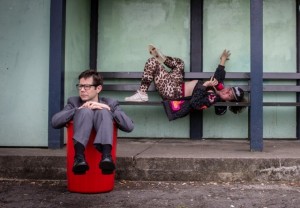
BeautifulMess: The Loneliness Street Cabaret. Photo Kerrin Kokot
This year, GDIF’s annual ‘festival within a festival’, Greenwich Fair features a rich and diverse weekend of work presented in parks and streets.
Winding through the crowds along King William Walk, a noisy woman with mad hair and a running commentary of the fair finds her spot and starts her piece. The Loneliness Street Cabaret, by Lambeth based company BeautifulMess, prides itself in addressing socially relevant themes and performing in deprived places and areas of gentrification to highlight the tension in their messages about love and loneliness in a society dominated by earning money and being absorbed in technology. This woman (played by BeautifulMess founder Kati Francis) roams the grounds of the Old Royal Naval College all afternoon, as a bag lady slash DJ, cleverly making her presence unmissable. She gradually builds up the entertainment in her spot enticing passers-by until the area is jam-packed with viewers. Wearing purple shoes and carrying a guitar, she pushes a buggy occupied by a stuffed baby, and makes quick changes in full view. The cabaret is a great singalong for people who have no qualms about joining in. The Italian business worker nicknamed Spaghetti (played by Andrea Foa) is the butt of the jokes as he is made to play the guitar with the music taped to his feet and his bottom stuck in a dustbin. The content focuses on the unhealthy structure of the 9-5 office day and the office workers’ dislocation with the people around them. This is a well-worn theme which BeautifulMess struggle to interrogate deeply, but as a piece of family-friendly street theatre it is a great success. The slapstick and silliness, wacky wigs and characters getting stuck in dustbins enthral the younger members of the audience, who are as noisy as the performers. By escaping his suit, the Italian businessman feels free and liberated in his pants and string vest encouraging all of us to join him as the performers sing and dance together in their underwear: if only escaping gentrification and a society built on overworking and unhealthy structures were as easy to escape.
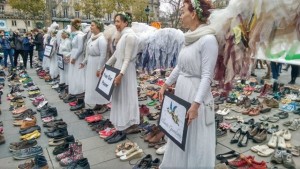
Cimate Guardians: Shoes for Hope
A spot of wing making is next on the agenda, with six or seven elegant women in white sporting wide-spanned wings. They are majestic angels whose visual attraction works well with their political message. They are guardians of our planet and of future generations. Their Wing Making Workshop is combined with Shoes for Hope, where festival goers are invited to leave their shoes for a short while to create a moment of solidarity in the wake of climate change, and in support of the cause to help maintain the planet. The guardian angels protect the shoes as they stand in protest for us. With dark black thunder clouds looming over this busy team of beavering angels, a sense of urgency, of time passing and transience, make the work of peaceful activism ever more poignant and ephemeral. Scattered by the rain, the angels disappear to the elements reminding us how fragile and at mercy to the elements our time on this planet is. All the materials for the wings are recycled and children and adults create a vision in white as they disperse into the crowds. Originating in Australia, their message runs worldwide as the Climate Guardians campaign internationally with their manifesto for change around renewable energy and a response to climate change.
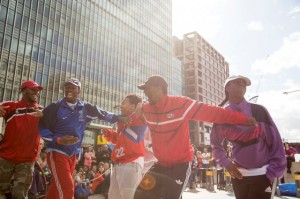
Far From the Norm : H.O.H. Photo Stuart Mayhew
And so the rains came. Saturday’s festival becomes as damp as the giant squid whose dismembered human sized tentacles hover on sticks above the crowds (Puppets with GUTS’ Citizen Squid). Its bulbous orange body bobs about in the oversized puppetry parade as a metaphor for the displacement and dislocation of people in society. Surrounded by heavy rain and the heavy hearted, Far From the Norm company pull out a show stopper just in time in H.O.H. (House of Hooligans) presented by Far From the Norm. Audiences are reduced somewhat to a sea of umbrellas and heads poking out from the Tiger Moth Pub or the Cutty Shark Ship, but the energy ranks up and up. Huge smiles, bright colours and big voices declare ownership of the Cutty Sark Gardens the second the beat drops. Carefully choreographed floor patterns and well-timed phrases delight in this feast of hip hop and breakdancing, a style that can often fall behind in terms of choreographic form and structure. H.O.H is more than a break battle; it is a series of dances incorporating satire, speech, and political characters in tableaux and moving formations. From CCs to Suzie Qs, Charleston to Lindy Hop, the team of football supporters even manage a few windmills in the downpour. Refreshingly, their grasp of footwork means that they don’t rely on the spectacle of power moves to please a crowd – their complex choreography certainly hits the spot. The narrative and speech was not always clear in the downpour as the politically charged piece speaks out against football violence. However the message hovering over everyone’s lips that day is the momentous EU referendum that has shaken up the nerves, content and futures of the programme’s international performances. Subtle references, messages and acts of protest pop up throughout the work at the Greenwich Fair this weekend.
In one last bid to fight the weather, Circus Katoen tiptoe out beneath the dripping trees for a tale of domestic games and intimate interaction. The couple appear to be a dainty flowerpot man and woman, but with the strength and cunning to walk on their hands and throw wood blocks with their feet. They back flip and balance a plank of wood and each other in precarious positions as they build a little home together. Ex Aequo is charming and compelling with risky balances and tricks that are embedded in a sophisticated form. Unfortunately the downpour cuts the piece short and the Fair’s final stalwart attendees scatter. I take my sodden self home, determined to start again tomorrow.
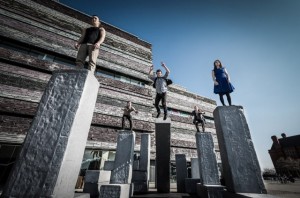
Motionhouse / NoFit State: Block. Photo Dan Tucker
Sunday’s sunshine makes the previous day’s festival follies a distant memory as the Cutty Sark ship floats in a sea of people rather than a sea of rain water, as Motionhouse and Nofit State Circus perform Block. This is a mighty performance centred around twenty large, grey polystyrene blocks. They feel monolithic, like a contemporary Stonehenge. Performers evolve from crab-like upside-down creatures, to predatorily aggressive dancers, to human beings, as they inhabit their monumental blocks. The monoliths subvert expectations with their lightness. This allows them to be constantly moving, rearranged, reordered, disordered, piled, stacked, tilted and collapsed. One minute they are supporting an acrobat balancing upside down, the next they are tumbling into disarray.
Both blocks and humans are flipped, tumbled, and rebuilt as one. Scene after scene of towers and shapes marvel spectators with dancers flying from great heights, jumping over barriers, and shooting through voids. Dancers are tilted off blocks, falling into continuous movement. The composition on stage is in constant flux: there is always a tableaux forming as one dissolves, with dancers free-running, balancing, somersaulting and tumbling. The work is a kaleidoscope of continuous acrobatics which only takes pause for breath at the highest of heights, with a handstand on top of a vertical block on top of a tower. A loose narrative hangs six sections together. The upside-down transition from animal to human open and closes the work. A building and surveying of territory is followed by the sudden expression of emotions and relationships with the exclusion of one from the pack. A negative, unproductive consequence emerges and a positive team effort to rebuild the blocks into a magnificent tower presides. But the narrative is tenuous and sometimes clunky, with a disconnect between physical form and human emotion. Acting scenes jar against the flow of continuous tumbling and rebuilding and sit at odds with the highly physical, formal aspects of the piece.
Motionhouse aims to integrate the skills and circus tricks of Nofit State into a dance vocabulary. This results in a highly physical, fast-paced style that encompasses the expansive, jumping, tumbling and travelling dance vocabulary with that of the spectacle of circus. This collaboration does it with magnificence, strength and finesse. Motionhouse however, struggles to find the individuality and musicality in the expression of finely nuanced gestures and complex isolations that dance has to offer. A tiny gestural section stood on perpendicular blocks doesn’t go anywhere. The penultimate section where characters come together in a natural play and banter to build a tower together is the strongest section. Dancers create a tower or an office block, scaling its sides and swinging out, in and around their creation, diving through the voids. This reveals the personality of the performers and the cracks in the physical and metaphorical structures that society builds. It is fast moving, funny, daring and death defying, whilst the tension between humanness and city life prevails.
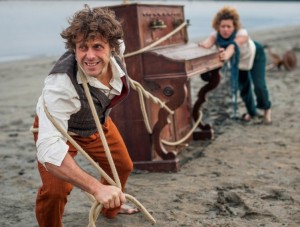
D’irque & Fien: Sol Bemol
Thoroughly wowed and satisfied, it’s time to settle down with my Portuguese street food from Greenwich Market before two wooden cranes, set in front of the grand Corinthian capitals of the neo-classical Old Royal Naval College. D’irque & Fien are a Flemish company who tour internationally with their work that infuses aerial skills with piano playing. Cascading keys illustrate an ascension of both human and piano that surprises in its tenderness and elegance. The content and structure of the set of Sol Bemol derives from sailing, as is fitting for its naval situation, but is taken beyond a representation and abstracted in order to interrogate the creative potential of the set. The cranes that resemble masts support a vast fabric awning that is sometimes a sail, sometimes a vast ocean, and at others a napkin or wine glass. The manipulation of the bellowing fabric allows for people and props to magically emerge and disappear whilst the cranes suspend this sail, along with humans and pianos, who all take their turn to take flight.
A tale of travel and discovery is derived from the play of objects and the intimate relationship between Dirk Van Boxelaere and Fien Van Herwegen that emotionally engages the audience. She plays the piano while he bumbles about, juggling, climbing and sawing above her. Their relationship with the stage handlers cum sailors subtly places them in and out of the piece. Two pianos become three as they precariously balance one above the other. When a fourth piano appears, a gasping audience watches the tower of full-sized pianos grow once more as all four characters climb to play their keys. This is a wonderfully thoughtful, musical piece that has a calm and graceful tone that sets it apart from the explosive colour, energy and noise of other acts. The vignettes and narrative makes the emergence of a piano suspended by ropes from a crane completely plausible, and the loveable characters of the duo delight throughout.Joli Vyann collaborates with choreographer Florence Caillon in the Without Walls production Lance Moi En L’air. The work is about ‘compatible contradictions’ which ebb and flow in a relationship. The couple grow, breathe, sleep and awaken each other. Their pas de deux catapults, catches, supports and nourishes each other in turn. Incredible strength and skill allows Olivia Quayle to stand on Jan Patzke’s head, to spiral around his body and to hover, half in flight attached to him like blowing leaves around a solid and safe great tree trunk. The style and ambience of this piece is of abandonment and sensitivity, with control, strength and momentum coated by a relaxed sense of release that maintains an intriguing tension throughout. The title, which translates as ‘launch me in the air’, captures the support, catalysts for change, interventions and safety exchanged in a relationship of risk and balance. Joli Vyann’s sophisticated style means that tricks are embellished and altered by choreographic nuances, and the piece works as a mesmerising whole, stripping back the spectacle and leaving great sets, props and robots to others. Two people draw their audience into a melodic duet that is ever churning, undulating and flying. The choreography shows incredible strength, skill and precision as they balance upside down on various limbs and tumble out of the air, whilst a tenderness to their style makes Lance Moi En L’air truly unique.
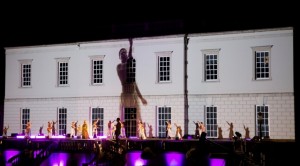
The House, opening GDIF 2016
GDIF 2016 took place at various sites throughout Greenwich and East London, 24 June to 2 July 2016.
Rebecca Nice attended the Greenwich Fair, part of the Greenwich and Docklands International Festival, 25 & 26 June 2016.
Greenwich+Docklands International Festival is supported by Arts Council England, the London borough of Tower Hamlets, the Royal Borough of Greenwich, and Royal Greenwich Festivals.
www.festival.org

